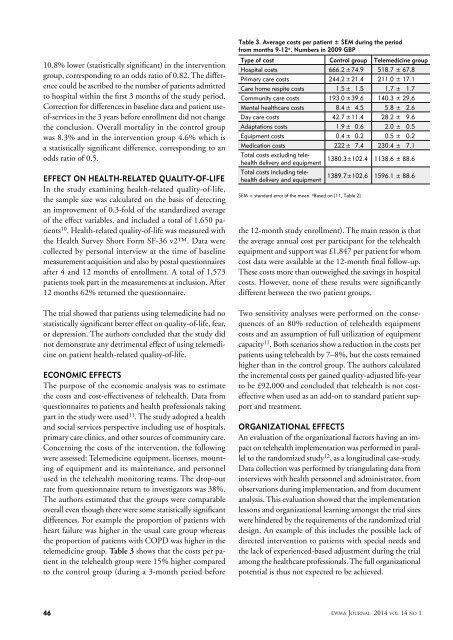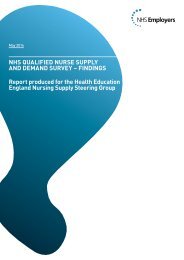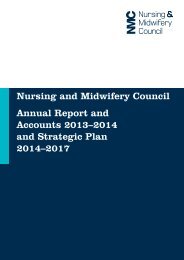Journal_1_2014_final_WEB
Journal_1_2014_final_WEB
Journal_1_2014_final_WEB
Create successful ePaper yourself
Turn your PDF publications into a flip-book with our unique Google optimized e-Paper software.
10.8% lower (statistically significant) in the intervention<br />
group, corresponding to an odds ratio of 0.82. The difference<br />
could be ascribed to the number of patients admitted<br />
to hospital within the first 3 months of the study period.<br />
Correction for differences in baseline data and patient useof-services<br />
in the 3 years before enrollment did not change<br />
the conclusion. Overall mortality in the control group<br />
was 8.3% and in the intervention group 4.6% which is<br />
a statistically significant difference, corresponding to an<br />
odds ratio of 0.5.<br />
Effect on health-related quality-of-life<br />
In the study examining health-related quality-of-life,<br />
the sample size was calculated on the basis of detecting<br />
an improvement of 0.3-fold of the standardized average<br />
of the effect variables, and included a total of 1,650 patients<br />
10 . Health-related quality-of-life was measured with<br />
the Health Survey Short Form SF-36 v2. Data were<br />
collected by personal interview at the time of baseline<br />
measurement acquisition and also by postal questionnaires<br />
after 4 and 12 months of enrollment. A total of 1,573<br />
patients took part in the measurements at inclusion. After<br />
12 months 62% returned the questionnaire.<br />
The trial showed that patients using telemedicine had no<br />
statistically significant better effect on quality-of-life, fear,<br />
or depression. The authors concluded that the study did<br />
not demonstrate any detrimental effect of using telemedicine<br />
on patient health-related quality-of-life.<br />
Economic effects<br />
The purpose of the economic analysis was to estimate<br />
the costs and cost-effectiveness of telehealth. Data from<br />
questionnaires to patients and health professionals taking<br />
part in the study were used 11 . The study adopted a health<br />
and social services perspective including use of hospitals,<br />
primary care clinics, and other sources of community care.<br />
Concerning the costs of the intervention, the following<br />
were assessed: Telemedicine equipment, licenses, mounting<br />
of equipment and its maintenance, and personnel<br />
used in the telehealth monitoring teams. The drop-out<br />
rate from questionnaire return to investigators was 38%.<br />
The authors estimated that the groups were comparable<br />
overall even though there were some statistically significant<br />
differences. For example the proportion of patients with<br />
heart failure was higher in the usual care group whereas<br />
the proportion of patients with COPD was higher in the<br />
telemedicine group. Table 3 shows that the costs per patient<br />
in the telehealth group were 15% higher compared<br />
to the control group (during a 3-month period before<br />
Table 3. Average costs per patient ± SEM during the period<br />
from months 9-12 a . Numbers in 2009 GBP<br />
Type of cost Control group Telemedicine group<br />
Hospital costs 666.2 ± 74.9 518.7 ± 67.8<br />
Primary care costs 244.2 ± 21.4 211.0 ± 17.1<br />
Care home respite costs 1.5 ± 1.5 1.7 ± 1.7<br />
Community care costs 193.0 ± 39.6 140.3 ± 29.6<br />
Mental healthcare costs 8.4 ± 4.5 5.8 ± 2.6<br />
Day care costs 42.7 ± 11.4 28.2 ± 9.6<br />
Adaptations costs 1.9 ± 0.6 2.0 ± 0.5<br />
Equipment costs 0.4 ± 0.2 0.5 ± 0.2<br />
Medication costs 222 ± 7.4 230.4 ± 7.1<br />
Total costs excluding telehealth<br />
delivery and equipment<br />
1380.3 ± 102.4 1138.6 ± 88.6<br />
Total costs including telehealth<br />
delivery and equipment<br />
1389.7 ± 102.6 1596.1 ± 88.6<br />
SEM = standard error of the mean. a Based on [11, Table 2]<br />
the 12-month study enrollment). The main reason is that<br />
the average annual cost per participant for the telehealth<br />
equipment and support was £1,847 per patient for whom<br />
cost data were available at the 12-month <strong>final</strong> follow-up.<br />
These costs more than outweighed the savings in hospital<br />
costs. However, none of these results were significantly<br />
different between the two patient groups.<br />
Two sensitivity analyses were performed on the consequences<br />
of an 80% reduction of telehealth equipment<br />
costs and an assumption of full utilization of equipment<br />
capacity 11 . Both scenarios show a reduction in the costs per<br />
patients using telehealth by 7–8%, but the costs remained<br />
higher than in the control group. The authors calculated<br />
the incremental costs per gained quality-adjusted life-year<br />
to be £92,000 and concluded that telehealth is not costeffective<br />
when used as an add-on to standard patient support<br />
and treatment.<br />
Organizational effects<br />
An evaluation of the organizational factors having an impact<br />
on telehealth implementation was performed in parallel<br />
to the randomized study 12 , as a longitudinal case-study.<br />
Data collection was performed by triangulating data from<br />
interviews with health personnel and administrator, from<br />
observations during implementation, and from document<br />
analysis. This evaluation showed that the implementation<br />
lessons and organizational learning amongst the trial sites<br />
were hindered by the requirements of the randomized trial<br />
design. An example of this includes the possible lack of<br />
directed intervention to patients with special needs and<br />
the lack of experienced-based adjustment during the trial<br />
among the healthcare professionals. The full organizational<br />
potential is thus not expected to be achieved.<br />
46<br />
EWMA <strong>Journal</strong> <strong>2014</strong> vol 14 no 1




